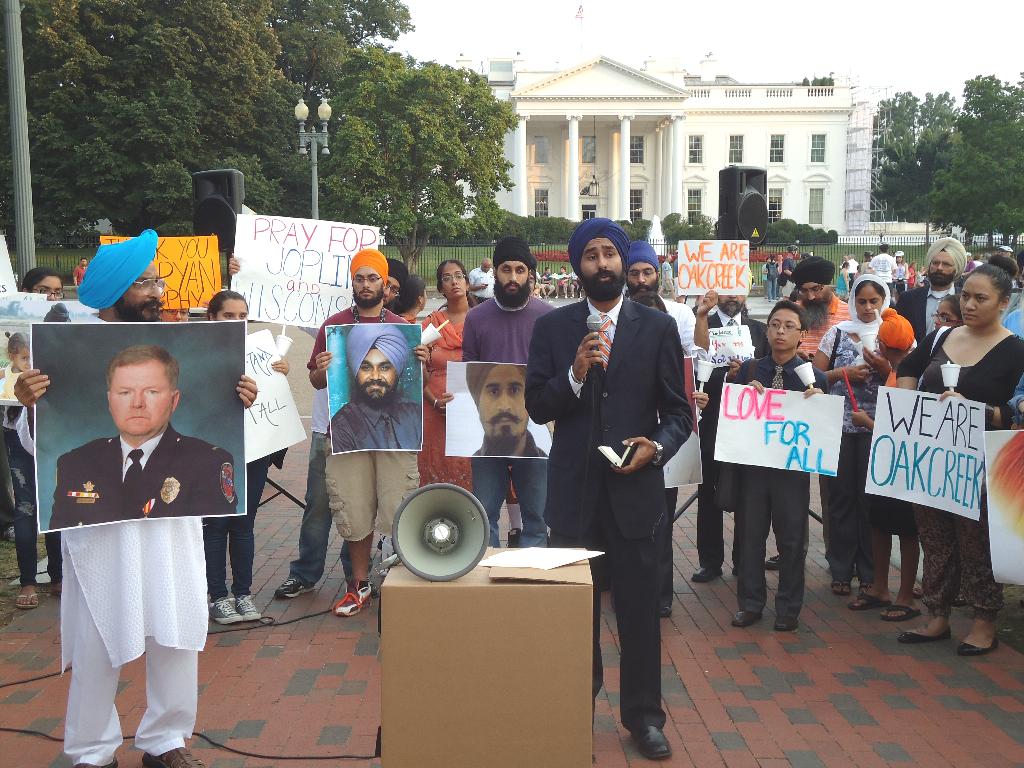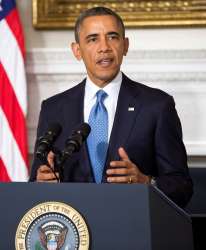August 14, 2012
By Geeta Goindi
WASHINGTON – The first Candlelight Vigil outside the White House, honoring the victims of the Oak Creek Gurudwara tragedy and expressing solidarity with the Sikh community, was held Wednesday by a group of young activists led by Dilroop Sidhu, Gursean Singh, Sabrina Mangat and Sahib Kaur.

August 14, 2012
By Geeta Goindi
WASHINGTON – The first Candlelight Vigil outside the White House, honoring the victims of the Oak Creek Gurudwara tragedy and expressing solidarity with the Sikh community, was held Wednesday by a group of young activists led by Dilroop Sidhu, Gursean Singh, Sabrina Mangat and Sahib Kaur.

A moving scene at the first Candlelight Vigil outside the White House, on Wednesday, honoring the innocent souls of the shootings at the Sikh Gurudwara in Wisconsin. Navdeep Singh, Policy Advisor at SALDEF (Sikh American Legal Defense and Education Fund), is addressing the gathering against the backdrop of the White House with the American flag at half mast
People from all walks of life stood ‘United Against Hate’, sending a strong message of peace, love and compassion. It was the order of the day, indeed days, following the massacre in Milwaukee!
In what has been acknowledged by the US administration as a hate crime, a lone gunman Wade Michael Page went on a shooting spree at the Sikh temple killing six innocent souls: Satwant Singh Kaleka, 65, the temple president who tried to protect others at the cost of his own life; Ranjit Singh, 49, and his 41-year-old brother Sita Singh,, both priests with families in India; Suveg Singh Khattra, 84, a former farmer and regular Gurudwara goer; Prakash Singh, 39, a priest; and Paramjit Kaur, 41, who worked 66 hours a week to provide for her family. Three others remain in critical condition, including the heroic police officer Brian Murphy.
In the face of such a heinous hate crime, Oak Creek Police Chief John Edwards marveled at the composure and fortitude of the Sikh community. “In 28 years of law enforcement, I have seen a lot of hate”, he said. “I have seen a lot of revenge. I’ve seen a lot of anger. What I saw, particularly from the Sikh community this week, was compassion, concern, support. What I didn’t see was hate. I did not see revenge. I didn’t see any of that. And in law enforcement that’s unusual to not see that reaction to something like this. I want you all to understand how unique that is”.

Members of the Sikh community at a Candlelight Vigil in the nation’s capital
Observing August 8 as a National Day of Remembrance and Solidarity, volunteers stood with photographs of the victims and placards outside the White House proclaiming ‘Chardi Kala’ (the positive attitude), ‘Always Love’, ‘Love for All’, ‘United Against Hate’, and ‘We are Oak Creek’. In Lafayette Square Park, across from the President’s official residence, people wrote messages of condolence and sympathy on a sheet spread on the lawn. It was a time of remembrance and reflection!
And of prayer. Bhai Sahib Gurdarshan Singh, Head Granthi (priest) of the Guru Gobind Singh Foundation, in Rockville, led the gathering in praying for the victims and for peace and unity. When we are enlightened, at one with God, there is no hate, he affirmed.

Little children at the first Candlelight Vigil outside the White House, on Wednesday, honoring the innocent souls of the shootings at the Sikh Gurudwara in Wisconsin
Noting that the Martin Luther King, Jr. Memorial is just a few blocks away from the vigil venue, Dr. Natasha Kaur quoted the prominent civil rights leader of the 1960s who said, “Only in the darkness can you see the stars”. In the same vein, she pointed out that “on Sunday, we saw the darkest side of mankind (Wade Michael Page) and we also saw the most brilliant (Lieutenant Brian Murphy and Satwant Singh Kaleka)”.
Currently doing her residency at the George Washington University Hospital, Natasha noted that “bullying, hateful slurs, employment discrimination, socio-economic discrimination and racial profiling is a common story for Sikh households and other American homes”. She expressed gratitude “to law enforcement agencies around the country for making us feel safe and to the media for educating the American public about Sikhs”. But, she underscored that law enforcement alone cannot offer protection. “We must eliminate the hate that fuels this violence”, she said, placing the responsibility on educators, policy-makers, religious leaders and families.

Heartfelt messages for the victims of the tragedy in Oak Creek, at Lafayette Square Park, across from the White House
Mr. Ralph Belk, Deputy Executive Director of Program Administration for the National Center for Children and Families – a non-profit agency serving homeless families, victims of domestic violence and adolescents who are abused or neglected – denounced the “horrific act of hate that took place at the Sikh temple”. Speaking on behalf on his entire agency, he said: “We extend our love to all those who are hurt and wounded by these atrocities and our hearts and prayers go out to the Sikh community worldwide! It is unfortunate that hate and ignorance can reach such a catastrophic extent and take so many precious lives especially against a community that is so closely knit into the fabric of our nation. It is at times like these that we need to reach out to our brothers and sisters, our neighbors, and let them know that we stand with them and more importantly, that we stand against hate”!
The carnage on Sunday is being ascribed to a case of ‘mistaken identity’ – Sikhs are being mistaken for Muslims which is a terrible attribution. Hate is hate; it doesn’t matter who is the target!
At the candlelight vigil, Sadiya Abjani, Outreach Coordinator at South Asian Americans Leading Together (SAALT), a national non-profit organization dedicated to amplifying the voices of South Asians in America, expressed the solidarity which is being keenly felt in communities across the nation! “As an American Muslim myself, I know that Muslims stand in solidarity with Sikh Americans during this terrible time of loss”, she told the gathering. “Tonight, we come together to say we are not Muslim, we are not Jain or Hindu. We are all Sikh and we stand united! Our collective voices send out the message that as a nation we must denounce the hate-fueled sentiment and bigoted rhetoric that has become commonplace in our public and political discourse”, she said.

People stand ‘United Against Hate’ at the first Candlelight Vigil outside the White House
Sadiya lamented the fact that “the massacre at the Sikh temple is part of a history of bias and violence that members of Sikh, Muslim and South Asian communities have endured in the decade following September 11, 2001. Community members continue to report discrimination and places of worship are routinely targeted”, she said, pointing out that within 24 hours of the attack in Wisconsin, a suspected arson destroyed a mosque in Joplin, Missouri.
She believed the need of the hour is concerted action. “We must take the steps, each of us, to say, ‘Enough is enough’, she declared. “Our country is becoming increasingly diverse and we have a responsibility to meaningfully learn about and include individuals of different backgrounds and faiths in our civic institutions, work places and schools”.
Noting that there are some 10,000 Sikhs in the Washington metropolitan area and about 500,000 in the US, Sartaj Singh, emcee of the event, said, “We are one of the most visible faiths, but also one of the most misunderstood”.
It’s really sad that it took something so tragic as the shootings in Wisconsin to shatter our complacency and serve as a wake-up call! Sartaj noted, “Last week, we were introduced to the city of Oak Creek, in Wisconsin, a place most of us had never heard of before. On account of the unfortunate event, it became a household name in America”!
He stressed that Sikhs have time and again displayed determination and resolve in the most trying of circumstances, endured the greatest sacrilege – on Sunday, the gunman entered the Holy precincts of the Gurudwara and shot innocent, hard-working, honest people. “Our community is a minority and we have faced oppression for years, misunderstanding, not knowing who we are”, Sartaj said. “The identity that you see on my head (turban) is a symbol that represents truth, passion, equal rights, human rights, civil rights, justice for all”!
Sartaj was grateful for the exposure that Sikhs have been getting in the last few days – neighbors coming over and talking to them, people leaving flowers outside Gurudwaras, the extensive press and media coverage. “The media is doing a fabulous job of educating everyone about who we are”, he said, appreciatively.
Navdeep Singh, Policy Advisor at the Sikh American Legal Defense and Education Fund (SALDEF), pointed out that the turnout at the vigil is “an expression of the solidarity and unity that joins us as Americans. This is a symbol of the true America”, he said. “We stand here today in front of the White House, with the flag at half mast, as a symbol of national unity. Everyone across this nation was affected” by the tragedy in Wisconsin.

Young volunteers holding photographs of the victims of the Oak Creek Sikh Gurudwara shootings and placards of peace and love, outside the White House
Navdeep drove home the point that the shooting “is not a reason for us to live in fear. In Sikhism, we have this philosophy of ‘Chardi Kala’, an eternal optimism”, he told the gathering.
But, for 12-year-old Hana Kaur of Maryland, her sense of security has been eroded. “My first reaction to the shooting was shock”, she recalled. “I could not imagine someone barging into any house of worship with a gun and a motive to kill. A Gurudwara has always appeared to me as a safe place. But, this incident has changed my perception of all religious institutions. It has created a huge dilemma for me and my community because we have never stopped anyone from coming into our temple. Before the shooting, I never considered myself as an outsider”.
Even at the tender, young age of 12, she balked at the idea that the shooting was racially motivated. “Some are saying that this is a case of mistaken identity – that the shooter thought of us as Muslims”, she said. “But, so what? Even if we were Muslims, why should it matter?”
She bemoaned the fact that people are largely ignorant about Sikhism. “We have not done our job well in educating them about our faith”, she said, citing the example of the Montgomery County School curriculum in which Sikhism is not taught as one of the five major religions of the world.
Hana believed that “people discriminate because they are intimidated by differences. They do not understand that it is our differences that we all have in common. Because we are unified, if something hurts one of us, it hurts all of us”, she said.







































































































